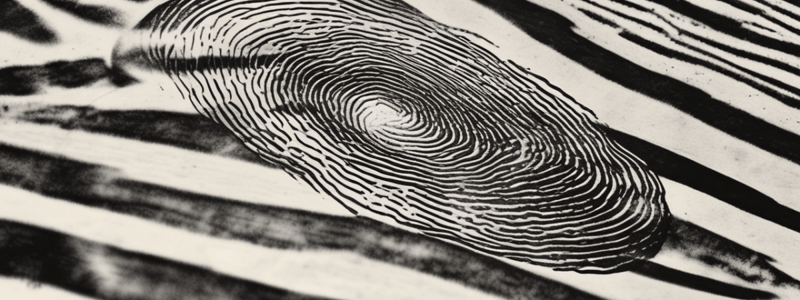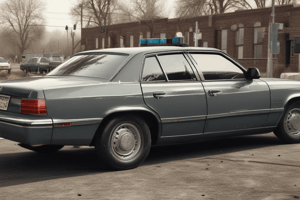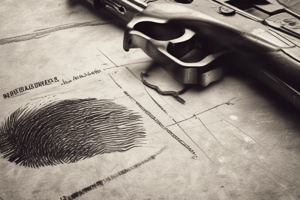Podcast
Questions and Answers
What is the primary purpose of this lesson?
What is the primary purpose of this lesson?
- To study the psychology of criminals
- To understand the process of collecting and analyzing fingerprint evidence (correct)
- To learn how to conduct a crime scene investigation
- To learn how to analyze DNA evidence
What are the three primary pattern groups used to classify fingerprints?
What are the three primary pattern groups used to classify fingerprints?
- Finger, toe, and palm prints
- latent, patent, and plastic prints
- Circles, spirals, and zigzags
- Arches, loops, and whorls (correct)
What is the purpose of obtaining both suspect and elimination fingerprint impressions?
What is the purpose of obtaining both suspect and elimination fingerprint impressions?
- To compare the fingerprints to a database
- To eliminate the possibility of the suspect being at the crime scene (correct)
- To compare the fingerprints to known criminal prints
- To determine the identity of the suspect
What type of surfaces are used to practice locating, developing, and lifting latent fingerprints?
What type of surfaces are used to practice locating, developing, and lifting latent fingerprints?
What is the purpose of recording both suspect and elimination fingerprints?
What is the purpose of recording both suspect and elimination fingerprints?
What is the primary method used to retrieve fingerprints from various surfaces?
What is the primary method used to retrieve fingerprints from various surfaces?
What is the purpose of washing hands before taking rolled fingerprints?
What is the purpose of washing hands before taking rolled fingerprints?
How should the fingers be rolled during the recording process?
How should the fingers be rolled during the recording process?
What is the preferred color of a good fingerprint impression?
What is the preferred color of a good fingerprint impression?
What is the main cause of poorly prepared fingerprint records?
What is the main cause of poorly prepared fingerprint records?
Why are bricklayers, wire splicers, and dishwashers more likely to have indistinct ridge characteristics?
Why are bricklayers, wire splicers, and dishwashers more likely to have indistinct ridge characteristics?
Why is it important to mark the space for missing digits?
Why is it important to mark the space for missing digits?
What is the composition of a fingerprint?
What is the composition of a fingerprint?
What is the most common type of fingerprint classification?
What is the most common type of fingerprint classification?
What is the purpose of using a flashlight to locate fingerprints at a crime scene?
What is the purpose of using a flashlight to locate fingerprints at a crime scene?
What is the purpose of using powder and brush to obtain fingerprints?
What is the purpose of using powder and brush to obtain fingerprints?
What is the purpose of the standard 10-print record card?
What is the purpose of the standard 10-print record card?
What is the primary basis of fingerprint identification?
What is the primary basis of fingerprint identification?
What is the purpose of using iodine fuming to detect fingerprints?
What is the purpose of using iodine fuming to detect fingerprints?
What is the recommended way to prepare a glass plate for recording fingerprints?
What is the recommended way to prepare a glass plate for recording fingerprints?
What is the purpose of using clear scotch tape to lift fingerprints?
What is the purpose of using clear scotch tape to lift fingerprints?
What is the primary factor that affects the quality of a fingerprint impression?
What is the primary factor that affects the quality of a fingerprint impression?
Flashcards are hidden until you start studying
Study Notes
Fingerprint Evidence
- Fingerprint is a deposit consisting of 98% perspiration, 1% amino acids, and 1% oil that forms on friction ridges of fingers, palms, and feet, and is left on a surface when contact is made.
Characteristics of Fingerprint Evidence
- Most common form of physical evidence.
- No two fingerprints are identical.
- Fingerprints found at a crime scene have a high potential for identifying perpetrators of a crime once the imprints of the victim and other non-suspects are ruled out.
- Fingerprints reveal the opportunity or presence factors important to the investigation.
Factors Affecting Quality of Fingerprint Impressions
- Condition of the hand (e.g. clean and dry, age can affect friction ridges, occupation of subject can affect friction ridges).
- Type of surface (e.g. smooth, hard, clean surfaces are most likely to reveal prints, rough, porous, dusty, dirty, or greasy surfaces are least likely to reveal fingerprint impressions).
- Atmospheric conditions.
Fingerprint Classifications
- Fingerprints are classified into three pattern groups: Arches (5% of population), Loops (60% of population), and Whorls (35% of population).
- Eight sub-groups: Plain Arch, Tented Arch, Radial Loop, Ulnar Loop, Plain Whorl, Double Loop Whorl, Accidental "Unusual" Whorl, and Central Pocket Loop Whorl.
Fingerprint Impressions
- Three types of fingerprint impressions: Patent (visible), Latent (invisible), and Plastic (molded).
- Methods used to obtain fingerprints at a crime scene: Powder and brush, Photography, and Chemicals (Iodine fuming, Ninhydrin, Silver nitrate, and Super Glue fuming).
Lifting Prints
- Precautions when dusting for fingerprints: use good clean equipment, proper amount of powder, and light movement of the brush.
- Fingerprint impressions can be retrieved (lifted) with clear scotch tape and placed on a card and retained as evidence.
Fingerprint Records
- Fingerprint identification is based on the premise that no two fingerprints are exactly alike.
- Fingerprint classification system is used to store and retrieve fingerprint cards for comparison.
- Ultimate value of fingerprint identification or classification depends upon properly prepared fingerprint records.
Recording Fingerprint Records
- Standard 10-Print Record Card is used by most law enforcement agencies.
- Two-part system: Rolled prints and Plain (PAT) prints.
- Fingerprint Recording Equipment: Commercially manufactured kit containing device for holding 10-print card, glass plate, ink, ink roller, and cleaning material.
Procedures for Recording Rolled Impressions
- Have subject sign 10-print card.
- Have subject wash hands.
- Have subject stand to immediate rear of recording officer.
- Roll four fingers away from center of subject's body.
- Roll thumbs toward center of subject's body.
- Grasp digits with both hands.
- Apply steady/even downward pressure.
- Impression should be roughly square in shape and fill appropriate digit box.
Procedures for Recording Plain (PAT) Impressions
- Have subject sign 10-print card.
- Have subject wash hands.
- Have subject stand to immediate rear of officer.
- Subject should hold fingers together straight and stiff.
- Hand and wrist form level plane/no break at wrist.
- Finger printer holds wrist and presses fingers simultaneously on ink pad, then onto print card in appropriate box.
- Thumbs held straight and pressed in appropriate boxes individually or together.
Studying That Suits You
Use AI to generate personalized quizzes and flashcards to suit your learning preferences.




